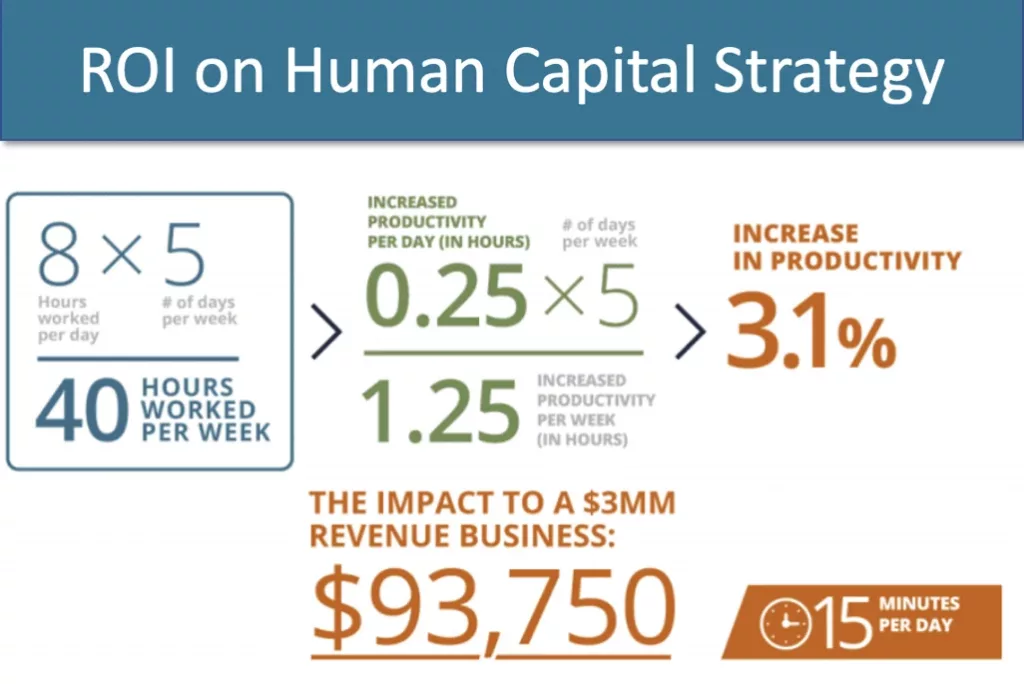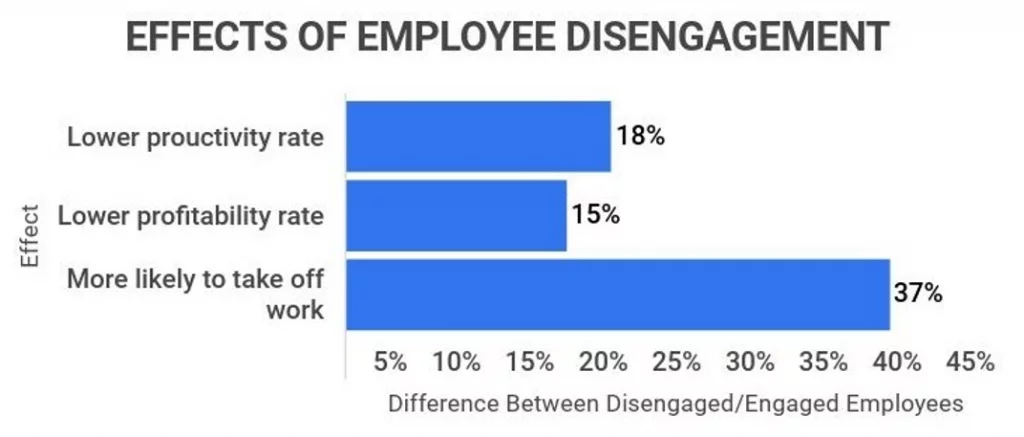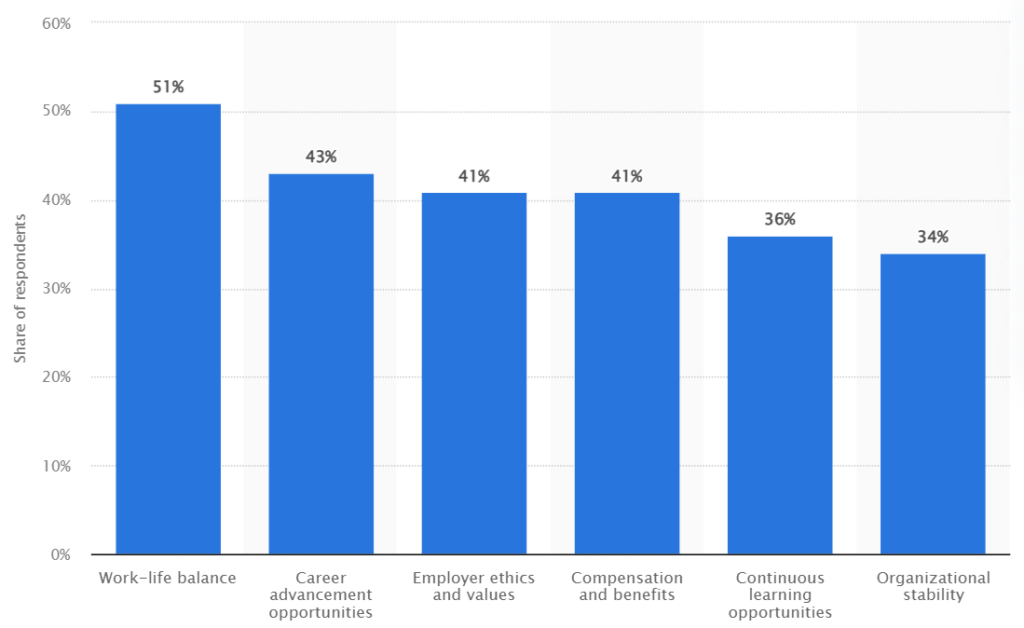By Craig Goodliffe
The heart of any organization is its employee, whether they’re entry-level or seasoned executives. Recognizing the intrinsic value of employees can save businesses more money than they expect. A recent report by Gallup states, “Employees who are not engaged or who are actively disengaged cost the world $7.8 trillion in lost productivity.”
Read that again. That’s $7.8 trillion — with a “T” — in lost productivity.
Recognizing the intrinsic value of employees isn’t enough. Organizations must recognize the value of investing in their workforce beyond traditional practices. This investment demands a holistic approach that encompasses professional growth, work-life balance, and a profound commitment to creating an uplifting work culture.
Source: https://www.wellable.co/blog/employee-engagement-statistics-you-should-know/
1. Boosts motivation and innovation
Motivation and innovation serve as the twin engines that drive companies forward, propelling them beyond the boundaries of mediocrity and toward groundbreaking achievements. A motivated workforce provides a sense of purpose and fulfillment. This sense of worth translates into an intrinsic motivation to excel in their roles, not merely driven by external rewards, but by an internal desire to make a meaningful impact.
In such an environment, innovation flourishes. When employees are motivated, they feel empowered to explore new ideas, take risks, and challenge the status quo. Creativity knows no bounds when individuals are encouraged to think outside the box, unafraid of failure, and confident in their abilities.
Innovative ideas are not born in isolation — they thrive in collaborative ecosystems. By investing in people with time and creating opportunities, organizations create spaces for open communication and idea sharing. When employees feel supported and encouraged to share their thoughts, a rich company culture of perspectives emerges, igniting the spark of innovation.
2. Fosters loyalty and commitment
Loyalty is not a one-sided affair; it is a bond forged through mutual trust and respect, not money. A recent McKinsey study found that “55 percent of employee engagement is driven by non-financial recognition.”
By investing in people, leaders demonstrate their commitment to the growth and progress of their employees. As employees see their leaders actively investing in their professional development and genuinely cultivating relationships, they become more inclined to remain loyal to the organization, knowing that their dedication is reciprocated and their potential is recognized.
A loyal and committed workforce forms the bedrock of a stable and resilient organization. Lower employee turnover reduces recruitment and training costs, allowing businesses to retain valuable institutional knowledge and experience. Such stability fosters a sense of continuity and purpose, enabling the organization to adapt to changes and challenges with steadfast determination.
Source: https://www.statista.com/statistics/1246966/job-satisfaction-factors-worldwide/
3. Drives productivity and efficiency
Satisfied employees drive productivity and efficiency because they feel valued, supported, and empowered, which will encourage them to invest time and energy in their work. To create a culture of satisfied employees, organizations must foster a culture of continuous improvement.
Employees are encouraged to seek out innovative solutions, streamline processes, and eliminate inefficiencies. As they take ownership of their work and contribute their ideas, the organization experiences a surge in productivity and a reduction in wasteful practices.
In an environment where employees are invested in the organization’s success, teamwork flourishes. Collaborative efforts bring diverse perspectives and skill sets to the table, resulting in effective problem-solving and streamlined workflows. As teams align their efforts and work cohesively, the organization experiences a surge in overall productivity and a noticeable boost in efficiency.
4. Attracts top talent
Attracting top talent begins with cultivating a positive employer brand. When an organization is known for its commitment to employee growth, work-life balance, and supportive work culture, it becomes an employer of choice. Potential candidates are drawn to companies that prioritize investing in people, recognizing the opportunities for personal and professional development.
Think about it this way: high-performing employees are 400 times more productive, and the top 5 percent of top-performing employees can create 26 percent of the business outcomes. Top talent seeks out organizations that offer meaningful and fulfilling work experiences. Investing in people includes providing opportunities for challenging projects, career advancement, and a sense of purpose. When potential candidates perceive an organization as a place where they can thrive and make a meaningful impact, they are more likely to seek employment with that company.
5. Enhances customer satisfaction
The connection between employee satisfaction and customer satisfaction is deeply intertwined. When employees feel valued and supported, they are more likely to go above and beyond to meet customer needs. A motivated and engaged workforce translates into happier, more attentive, and empathetic interactions with customers.
Investing in people goes beyond the transactional level to encompass a deep understanding of customer needs and a commitment to creating a positive customer experience. Employees invested in their professional growth and well-being are more inclined to identify and address customer pain points proactively, seeking to exceed expectations at every turn.
Empowering employees to take ownership of customer interactions fosters a sense of responsibility and pride in their roles. When employees are equipped with the necessary tools, training, and authority to resolve customer issues promptly, they can deliver seamless and efficient service, enhancing overall customer satisfaction.
Furthermore, investing in people cultivates a culture of continuous improvement centered on customer feedback. Organizations that prioritize customer feedback as part of their growth strategy can make informed decisions to enhance products, services, and customer support. This feedback loop, fueled by employee commitment and customer insights, becomes the driving force behind constant innovation and service excellence.
6. Accelerates sustainable growth
The pursuit of sustainable growth extends beyond the balance sheet to include ethical and responsible business practices. By investing in employee training, mentorship, and leadership programs, organizations build a talent pipeline that can adapt to the changing needs of the business landscape. A skilled and agile workforce is better equipped to seize opportunities, tackle challenges, and navigate market dynamics, fostering a culture of innovation and adaptability.
Moreover, a skilled workforce that knows their company supports them will foster a loyal workforce. Loyalty comes a long way when a company is faced with adversity. When organizations invest in their workforce, they experience significantly lower turnover rates. A recent study reported that 94 percent of employees would stay at a company if they invest in their careers.
Taking that into account — and the fact that constant employee turnover costs companies “one-half to two times the employee’s salary” — when an organization is experiencing hardships, a major employee exodus due to a dissatisfied workforce could break the organization. Building a company culture that values growth and resiliency and provides its employees with the necessary tools will ensure employee engagement and satisfaction, and therefore loyalty and commitment to the organization.
7. Maximizes return on investment

Source: https://www.growthforce.com/blog/understanding-roi-on-human-capital-increase-your-cash-flow
At the heart of maximizing ROI lies a focus on employee development and growth. By investing in training, mentorship, and professional advancement, organizations equip their workforce with the skills and knowledge needed to excel in their roles. This enhanced expertise translates into increased efficiency, reduced errors, and heightened productivity, resulting in tangible financial gains for the organization.
Furthermore, investing in people drives employee engagement and job satisfaction. Engaged employees are more likely to stay loyal to the organization, reducing turnover and the costly process of recruitment and onboarding. As employee retention rates soar, the organization experiences significant savings and increased stability, directly impacting the bottom line.
Maximizing ROI also entails cultivating a culture of innovation and problem-solving. Organizations that invest in their employees’ growth foster an environment where creativity and out-of-the-box thinking thrive. As employees bring innovative ideas to the table, the organization gains a competitive edge, leading to product enhancements, process improvements, and breakthrough innovations.
Additionally, investing in people contributes to the development of a strong employer brand. Organizations that prioritize employee well-being and growth become attractive destinations for top talent, reducing recruitment costs and attracting high-performing individuals who align with the organization’s values and mission.
The power of investing in people is not limited to the balance sheets — it echoes in the hearts and minds of employees, customers, and stakeholders alike. Organizations that embrace investing in their workforce elevate themselves as leaders in their industries, leaving an indelible mark on the world.
When the intrinsic value of employees is recognized and nurtured, the possibilities for growth and success are boundless. In the pursuit of greatness, investing in people stands as the cornerstone of a thriving and prosperous organization that leaves a legacy of positive impact for generations to come.
About the Author: Craig Goodliffe is an entrepreneur, job creator, and CEO/Founder of Cyberbacker, the leading provider of administrative support and virtual assistant services. Goodliffe is an expert on business development and shares his insight to help clients earn seven-figure incomes.


